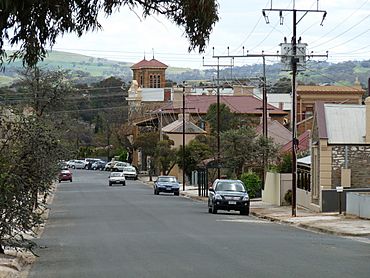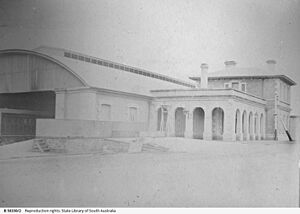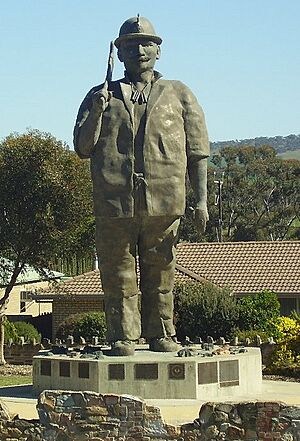Kapunda facts for kids
Quick facts for kids KapundaSouth Australia |
|||||||||||||||
|---|---|---|---|---|---|---|---|---|---|---|---|---|---|---|---|

Looking towards the Baptist church
|
|||||||||||||||
| Population | 2,917 (2016 census) | ||||||||||||||
| Established | 1839 | ||||||||||||||
| Postcode(s) | 5373 | ||||||||||||||
| Elevation | 245 m (804 ft) | ||||||||||||||
| Location | 77 km (48 mi) north of Adelaide | ||||||||||||||
| LGA(s) | Light Regional Council | ||||||||||||||
| State electorate(s) | Frome | ||||||||||||||
| Federal Division(s) | Barker | ||||||||||||||
|
|||||||||||||||
|
|||||||||||||||
Kapunda is a town in South Australia, located near the Barossa Valley on the Light River. It became a town after a big discovery of copper in 1842. In 2016, about 2,917 people lived there.
At the southern entrance to Kapunda, there is a large, 8-metre (26 ft) tall statue called Map Kernow. This name means "the son of Cornwall" and represents a traditional Cornish miner. The statue was built in 1988. It was damaged by fire in 2006 but has since been rebuilt.
Contents
Kapunda's History
Early Discoveries and Mining
In 1842, two sheep farmers, Francis Dutton and Charles Bagot, found copper ore in the area. They bought the land and started mining in 1844. At first, they dug up copper from the surface. By the end of the year, they were digging underground. Copper mining continued until 1879.
Kapunda also has quarries that produce beautiful marble, from dark blue to white. This marble was used to build parts of Parliament House, Adelaide in Adelaide.
Mining Operations and Workers
Initially, the copper ore was sent all the way to Wales for processing. But by 1851, Welsh experts came to South Australia, and the ore was processed right in Kapunda. Most of the miners were from Cornwall, while labourers were often Irish. The people who specialized in processing the ore were Welsh. Other people involved in trade and farming were Scottish and English. German farmers were already living nearby in Bethel.
As the mines got deeper, it became harder to dig underground. A steam engine was brought in 1847 to pump water out of the mines. Mining stopped for a while in 1851 because many people left to join the Victorian gold rush. It started again in 1855. In 1865, a Scottish company took over and began using "open-cut" mining, which means digging large open pits instead of tunnels. The mine finally closed in 1879 when copper prices dropped.
A railway line from Adelaide reached Kapunda in 1860. It was later extended to other towns like Eudunda and Morgan in 1878.
Local Government and Important People
The town of Kapunda got its own local government, called the Corporate Town of Kapunda, in 1865. The area around the town formed the District Council of Kapunda the next year.
The Baptist Church building was built in 1866.
Kapunda is famous for being the home of Sir Sidney Kidman (1859–1935). He was a very successful cattle farmer who owned a huge amount of land across Australia. He used to hold big horse sales in Kapunda, sometimes selling up to 3,000 horses in a week! His house, Eringa, was given to the Education Department in 1921. It was used by Kapunda High School until a fire badly damaged it in March 2022.
Kapunda was also home to several companies that made farm and mining machines. One important person, Tobias Richards, who started one of Australia's biggest coach-building companies, began his career here.
The town had a strong Catholic community. Saint Mary MacKillop, a very important figure in Australian history, visited Kapunda and helped set up a convent there.
What Kapunda is Like Today
The 8-metre (26 ft) tall statue of Map Kernow still stands at the southern entrance to Kapunda. It was rebuilt after a fire in 2006.
Today, Kapunda is known for growing cereal crops like wheat, barley, and oats. Local businesses also process these crops into things like animal feed. Kapunda also plays a part in the wine-growing industry nearby.
The Kapunda Historical Society runs a museum inside the old Baptist Church building.
Since 1976, Kapunda has hosted the Kapunda Celtic Music Festival, celebrating Celtic music and culture.
Kapunda has been called the "most haunted town in Australia" after a TV show featured it. This has led to more tourists visiting the area. The ruins of an old reformatory (a type of school for girls) outside the town were removed because of this.
The town is also close to the historic Anlaby Station, which has a large homestead, gardens, and other buildings. Many of these are being restored by their current owners.
Kapunda's Climate
Kapunda has a Mediterranean climate. This means it has very warm, dry summers and cool, wetter winters. Temperatures change throughout the year. The hottest average high is about 29.7 °C (85.5 °F) in January, and the coolest average high is about 13.5 °C (56.3 °F) in July. The average rainfall is about 491.7 mm (19.36 in) per year. The highest temperature ever recorded was 45.4 °C (113.7 °F) in January 1939, and the lowest was −3.3 °C (26.1 °F) in July 1959.
| Climate data for Kapunda (34º20'24"S, 138º55'12"E, 245 m AMSL) (1861-2024 normals, extremes 1927-1965) | |||||||||||||
|---|---|---|---|---|---|---|---|---|---|---|---|---|---|
| Month | Jan | Feb | Mar | Apr | May | Jun | Jul | Aug | Sep | Oct | Nov | Dec | Year |
| Record high °C (°F) | 45.4 (113.7) |
43.9 (111.0) |
42.4 (108.3) |
37.9 (100.2) |
29.8 (85.6) |
25.6 (78.1) |
22.6 (72.7) |
26.1 (79.0) |
32.4 (90.3) |
37.4 (99.3) |
42.2 (108.0) |
42.8 (109.0) |
45.4 (113.7) |
| Mean daily maximum °C (°F) | 29.7 (85.5) |
29.3 (84.7) |
26.6 (79.9) |
21.5 (70.7) |
17.5 (63.5) |
14.2 (57.6) |
13.5 (56.3) |
15.0 (59.0) |
17.9 (64.2) |
21.3 (70.3) |
25.1 (77.2) |
27.9 (82.2) |
21.6 (70.9) |
| Mean daily minimum °C (°F) | 14.5 (58.1) |
14.6 (58.3) |
12.7 (54.9) |
10.1 (50.2) |
7.9 (46.2) |
6.2 (43.2) |
5.3 (41.5) |
5.8 (42.4) |
6.9 (44.4) |
8.8 (47.8) |
11.2 (52.2) |
13.2 (55.8) |
9.8 (49.6) |
| Record low °C (°F) | 5.1 (41.2) |
6.1 (43.0) |
2.8 (37.0) |
1.7 (35.1) |
−0.3 (31.5) |
−2.8 (27.0) |
−3.3 (26.1) |
−1.7 (28.9) |
−1.1 (30.0) |
0.6 (33.1) |
1.6 (34.9) |
4.4 (39.9) |
−3.3 (26.1) |
| Average precipitation mm (inches) | 20.2 (0.80) |
20.5 (0.81) |
23.4 (0.92) |
37.4 (1.47) |
53.3 (2.10) |
57.6 (2.27) |
59.2 (2.33) |
61.6 (2.43) |
54.7 (2.15) |
46.0 (1.81) |
31.8 (1.25) |
26.0 (1.02) |
491.7 (19.36) |
| Average precipitation days (≥ 0.2 mm) | 3.9 | 3.5 | 4.6 | 7.3 | 10.8 | 12.7 | 14.3 | 14.5 | 11.8 | 9.6 | 6.6 | 5.2 | 104.8 |
| Average afternoon relative humidity (%) | 31 | 34 | 35 | 45 | 55 | 62 | 61 | 56 | 48 | 43 | 35 | 33 | 45 |
| Source: Bureau of Meteorology (1861-2024 normals, extremes 1927-1965) | |||||||||||||
Historic Buildings in Kapunda
St Rose of Lima Catholic Church
The current St Rose of Lima Catholic Church was built in 1938. It replaced an older church from 1866. The church has a special Romanesque Revival style, with long, narrow windows that look a bit like Eastern designs.
Eringa House
The house known as Eringa was built in 1876 by Alexander H. Greenshields. He called it Lanark House after his hometown in Scotland. Greenshields was an important person in Kapunda, owning a drapery business and being part of local groups.
Around 1900, Sidney Kidman bought the house and made it his home, renaming it Eringa. In 1921, he gave the building to Kapunda High School. It was used for classrooms, then as the library, and later as an administration building. The building is considered a heritage-listed site. In March 2022, a fire badly damaged the building, leaving mostly the walls standing.
Kapunda in the Media
Kapunda used to have several newspapers. The Kapunda Herald was printed in the town until 1951. It then joined with another paper to become the Barossa and Light Herald.
The North Kapunda Hotel was featured on a TV show called Haunting: Australia in 2014. This show explored Kapunda's reputation as "Australia's Most Haunted Town."
Healthcare in Kapunda
The Kapunda hospital is the main hospital in the Light Valley area. It also has Kapunda Homes, which is a facility for aged care.
Notable People from Kapunda
- Ellen Ida Benham (1871–1917), an education expert
- Vivian Bullwinkel (1915–2000), an Australian Army nurse and prisoner of war
- Walter Dyer (1882–1965), a New Zealand education leader
- Bert Hawke (1900–1986), a former Premier of Western Australia
- Rosanne Hawke (born 1953), an author
- Alice Rosman (1882–1961), a writer
- Sidney Kidman (1859–1935), a famous cattle farmer
- Darcie Brown (born 2003), a cricketer
Gallery









